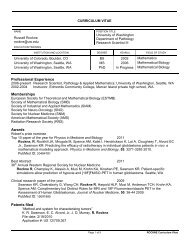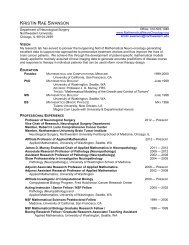April 25, 2005 4:19 WSPC/INSTRUCTION FILE paper2 ...
April 25, 2005 4:19 WSPC/INSTRUCTION FILE paper2 ...
April 25, 2005 4:19 WSPC/INSTRUCTION FILE paper2 ...
You also want an ePaper? Increase the reach of your titles
YUMPU automatically turns print PDFs into web optimized ePapers that Google loves.
<strong>April</strong> <strong>25</strong>, <strong>2005</strong> 4:<strong>19</strong> <strong>WSPC</strong>/<strong>INSTRUCTION</strong> <strong>FILE</strong> <strong>paper2</strong><br />
Mathematical Modelling of Glioblastoma Tumour Development: A Review 9<br />
trigger a variety of scenarios that may even lead to the creation of GBM. In this<br />
framework, the authors attempt to analyse the effect of these genetic alterations at<br />
the macroscopic level, namely in terms of tumour cell concentration. Moreover, the<br />
authors propose a way of tumour grade diagnosis by histological analysis of tumour<br />
parts.<br />
The appeal of this work lies in its multi-scaled nature. The authors develop a<br />
complete macroscopic mathematical description incorporating a stochastic sequence<br />
of genetic alterations (emerging increase in concentrations of malignant populations),<br />
in an attempt to ”guess” which of these genetic mutations are relevant for<br />
leading us to the clinically observed phenotype. However, the authors do not attempt<br />
to find minimal classes of events that lead to certain scenarios, i.e. identify<br />
minimal genetic profiles that result in a certain tumour (more speciffically malignancy<br />
grade).<br />
4.4. Modelling Therapies<br />
In this section, we discuss the mathematical modelling of glioma chemotherapy,<br />
tumour resection and radiation therapy. Of note, glioma radiotherapy has not been<br />
modelled so far.<br />
4.4.1. Chemotherapy<br />
Many GBM patients are treated with chemotherapy at some point during the course<br />
of their disease. Often a combination of drugs is administered to the patient in order<br />
to reduce the emergence of tumour cell clones resistant to a specific cytostatic agent.<br />
(a) Tracqui et al. (<strong>19</strong>95) 63 have analysed a patient with recurrent anaplastic<br />
astrocytoma, who was treated by chemotherapy. Serial CT scans were obtained<br />
during the 12 terminal months of a patient, as he was receiving 2<br />
different chemotherapies. The authors modelled chemotherapy as a spatially<br />
homogeneous (no assumption of differentiation into grey and white)<br />
equation of a reaction-diffusion system, namely: the rate of change of tumour<br />
cell population at a certain brain area (infinitesimally small) equals<br />
diffusion (motility) of tumour cells plus the net proliferation of tumour<br />
cells and loss of tumour cells due to chemotherapy. The serial CT scans<br />
determined the value of the parameters that best fit the model to the experimental<br />
data. The authors extended the model by the introduction of<br />
a second tumour cell population, sensitive to one chemotherapy but not<br />
the others. The model simulations agreed with the clinical data derived<br />
from CT scans. This work constitutes the first modelling attempt of glioma<br />
chemotherapy.<br />
However, this approach also has several disadvantages. The parameter values<br />
refer to a specific patient and have been used as the probable average<br />
of all high-grade gliomas. Consequently, they can be only indicative for





